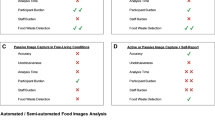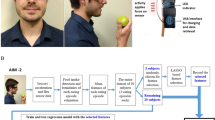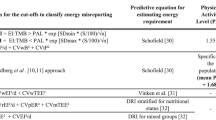ABSTRACT
Background/objectives
Regular monitoring of food intake is hardly integrated in clinical routine. Therefore, the aim was to examine the validity, accuracy, and applicability of an appropriate and also quick and easy-to-use tool for recording food intake in a clinical setting.
Subjects/methods
Two digital photography methods, the postMeal method with a picture after the meal, the pre–postMeal method with a picture before and after the meal, and the visual estimation method (plate diagram; PD) were compared against the reference method (weighed food records; WFR). A total of 420 dishes from lunch (7 weeks) were estimated with both photography methods and the visual method. Validity, applicability, accuracy, and precision of the estimation methods, and additionally food waste, macronutrient composition, and energy content were examined.
Results
Tests of validity revealed stronger correlations for photography methods (postMeal: r = 0.971, p < 0.001; pre–postMeal: r = 0.995, p < 0.001) compared to the visual estimation method (r = 0.810; p < 0.001). The pre–postMeal method showed smaller variability (bias < 1 g) and also smaller overestimation and underestimation. This method accurately and precisely estimated portion sizes in all food items. Furthermore, the total food waste was 22% for lunch over the study period. The highest food waste was observed in salads and the lowest in desserts.
Conclusions
The pre–postMeal digital photography method is valid, accurate, and applicable in monitoring food intake in clinical setting, which enables a quantitative and qualitative dietary assessment. Thus, nutritional care might be initiated earlier. This method might be also advantageous for quantitative and qualitative evaluation of food waste, with a resultantly reduction in costs.
This is a preview of subscription content, access via your institution
Access options
Subscribe to this journal
Receive 12 print issues and online access
$259.00 per year
only $21.58 per issue
Buy this article
- Purchase on Springer Link
- Instant access to full article PDF
Prices may be subject to local taxes which are calculated during checkout



Similar content being viewed by others
References
Kyle UG, Pirlich M, Schuetz T, Luebke HJ, Lochs H, Pichard C. Prevalence of malnutrition in 1760 patients at hospital admission: a controlled population study of body composition. Clin Nutr. 2003;22:473–81.
Pirlich M, Schutz T, Norman K, Gastell S, Lubke HJ, Bischoff SC, et al. The German hospital malnutrition study. Clin Nutr. 2006;25:563–72.
Kondrup J, Allison SP, Elia M, Vellas B, Plauth M. ESPEN guidelines for nutrition screening 2002. Clin Nutr. 2003;22:415–21.
Chen N, Lee YY, Rabb M, Schatz B. Toward dietary assessment via mobile phone video cameras. AMIA Annu Symp Proc. 2010;2010:106–10.
Sloendregt-Rösch S, Iff S, Leuenberger M, Knecht G, Sterchi A-B, Tanner B, et al. Entsprechen die Nährwerte der Vollkost aus der Patientengastronomie den Ernährungsempfehlungen? Schweiz Z für Ernähr. 2009;1:40–7.
Allison SP, Stanga Z. Basics in clinical nutrition: organization and legal aspects of nutritional care. E Spen Eur E J Clin Nutr Metab. 2008;4:14–6.
Barton AD, Beigg CL, Macdonald IA, Allison SP. High food wastage and low nutritional intakes in hospital patients. Clin Nutr. 2000;19:445–9.
Schindler K, Pernicka E, Laviano A, Schuetz T, Schneider SM, Singer P, et al. How nutritional risk is assessed and managed in European hospitals: a survey of 21007 patients. Findings from the 2007-8 cross-sectional nutritionDay survey. Clin Nutr. 2010;29:552–9.
Rutishauser IH. Dietary intake measurements. Public Health Nutr. 2005;8:1100–7.
Rüfenacht U, Rühlin M, Imoberdorf R, Ballmer PE. The plate diagram: an instrument to record insufficient dietary intake in hospitalized patients. Aktuel Ernahr. 2006;31:66–72.
Lazarte C, Encinas ME, Alegre C, Granfeldt Y. Validation of digital photographs, as a tool in 24-h recall, for the improvement of dietary assessment among rural populations in developing countries. Nutr J. 2012;11:61.
Vereecken C, Dohogne S, Covents M, Maes L. How accurate are adolescents in portion-size estimation using the computer tool Young Adolescents’ Nutrition Assessment on Computer (YANA-C)? Br J Nutr. 2010;103:1844–50.
Chung LM, Chung JW. Tele-dietetics with food images as dietary intake record in nutrition assessment. Telemed J E Health. 2010;16:691–8.
Ovaskainen ML, Paturi M, Reinivuo H, Hannila ML, Sinkko H, Lehtisalo J, et al. Accuracy in the estimation of food servings against the portions in food photographs. Eur J Clin Nutr. 2008;62:674–81.
Huybregts L, Roberfroid D, Lachat C, Van Camp J, Kolsteren P. Validity of photographs for food portion estimation in a rural West African setting. Public Health Nutr. 2008;11:581–7.
Martin CK, Newton RL Jr., Anton SD, Allen HR, Alfonso A, Han H, et al. Measurement of children’s food intake with digital photography and the effects of second servings upon food intake. Eat Behav. 2007;8:148–56.
Williamson DA, Allen HR, Martin PD, Alfonso AJ, Gerald B, Hunt A. Comparison of digital photography to weighed and visual estimation of portion sizes. J Am Diet Assoc. 2003;103:1139–45.
Ngo J, Engelen A, Molag M, Roesle J, Garcia-Segovia P, Serra-Majem L. A review of the use of information and communication technologies for dietary assessment. Br J Nutr. 2009;101:S102–12.
Samaras D, Samaras N, Bertrand PC, Forster A, Herrmann F, Lesourd B, et al. Comparison of the interobserver variability of 2 different methods of dietary assessment in a geriatric ward: a pilot study. J Am Med Dir Assoc. 2012;13:309 e9–13.
Williamson DA, Allen HR, Martin PD, Alfonso A, Gerald B, Hunt A. Digital photography: a new method for estimating food intake in cafeteria settings. Eat Weight Disord. 2004;9:24–8.
Parent M, Niezgoda H, Keller HH, Chambers LW, Daly S. Comparison of visual estimation methods for regular and modified textures: real-time vs digital imaging. J Acad Nutr Diet. 2012;112:1636–41.
Weiss R, Stumbo PJ, Divakaran A. Automatic food documentation and volume computation using digital imaging and electronic transmission. J Am Diet Assoc. 2010;110:42–4.
Kruizenga H, Van Tulder M, Seidell J, Thijs A, Ader H, van Bokhorst-de van der Schueren MA. Effectiveness and cost-effectiveness of early screening and treatment of malnourished patients. Am J Clin Nutr. 2005;82:1082–9.
Kruizenga H, Seidell J, de Vet H, Wierdsma N, van Bokhorst-de van der Schueren MA. Development and validation of a hospital screening tool for malnutrition: the short nutritional assessment questionnaire (SNAQ). Clin Nutr. 2005;24:75–82.
Bland JM, Altman DG. Measurement error. BMJ. 1996;313:744.
Lovie P. Coefficient of Variation. Encyclopedia of statistics in behavioral science. Hoboken, New Jersey: John Wiley & Sons, Ltd; 2005.
Olin AO, Osterberg P, Hadell K, Armyr I, Jerstrom S, Ljungqvist O. Energy-enriched hospital food to improve energy intake in elderly patients. JPEN J Parenter Enteral Nutr. 1996;20:93–7.
Easton V, McColl J. STEPS Statistics glossary. http://www.stats.gla.ac.uk/steps/glossary/ (1997).
Foster E, Matthews JN, Nelson M, Harris JM, Mathers JC, Adamson AJ. Accuracy of estimates of food portion size using food photographs--the importance of using age-appropriate tools. Public Health Nutr. 2006;9:509–14.
Bland JM, Altman DG. Statistical methods for assessing agreement between two methods of clinical measurement. Lancet. 1986;1:307–10.
Krouwer JS. Why Bland-Altman plots should use X, not (Y+X)/2 when X is a reference method. Stat Med. 2008;27:778–80.
Dale O, Salo M. The Helsinki Declaration, research guidelines and regulations: present and future editorial aspects. Acta Anaesthesiol Scand. 1996;40:771–2.
German Nutrition Society, Austrian Nutrition Society, Swiss society for Nutrition Research, Swiss Association for Nutrition. Reference levels for nutrient intake. Neustadt an der Weinstraße, Germany: Neuer Umschau Buchverlag; 2011.
Iff S, Leuenberger M, Rosch S, Knecht G, Tanner B, Stanga Z. Meeting the nutritional requirements of hospitalized patients: an interdisciplinary approach to hospital catering. Clin Nutr. 2008;27:800–5.
van Bokhorst-de van der Schueren MA, Roosemalen MM, Weijs PJ, Langius JA. High waste contributes to low food intake in hospitalized patients. Nutr Clin Pract. 2012;27:274–80.
Swanson M. Digital photography as a tool to measure school cafeteria consumption. J Sch Health. 2008;78:432–7.
Nelson M, Atkinson M, Darbyshire S. Food photography. I: the perception of food portion size from photographs. Br J Nutr. 1994;72:649–63.
Hernández T, Wilder L, Kuehn D, Rubotzky K, Moser-Veillon P, Godwin S, et al. Portion size estimation and expectation of accuracy. J Food Compos Anal. 2006;19:S14–S21.
Turconi G, Guarcello M, Berzolari FG, Carolei A, Bazzano R, Roggi C. An evaluation of a colour food photography atlas as a tool for quantifying food portion size in epidemiological dietary surveys. Eur J Clin Nutr. 2005;59:923–31.
Martin CK, Han H, Coulon SM, Allen HR, Champagne CM, Anton SD. A novel method to remotely measure food intake of free-living individuals in real time: the remote food photography method. Br J Nutr. 2009;101:446–56.
Simmons SF, Reuben D. Nutritional intake monitoring for nursing home residents: a comparison of staff documentation, direct observation, and photography methods. J Am Geriatr Soc. 2000;48:209–13.
Acknowledgements
We would like to thank all participants for taking part at the study and all colleagues from the ward for their help during the study.
Author contributions
EW, ML, and KS were responsible for conception and study design. EW was responsible for recruitment, study visits, collected the data, and conducted the statistical analyses. EW, ML, and KS undertook data interpretation. EW and ML wrote the first draft with contributions from KS. Finally, all authors reviewed and commented on subsequent drafts of the manuscript.
Funding
This research received no specific grant from any funding agency, commercial, or not-for-profit sectors.
Author information
Authors and Affiliations
Corresponding author
Ethics declarations
Conflict of interest
The authors declare that they have no conflict of interest.
Electronic supplementary material
41430_2018_126_MOESM1_ESM.docx
The online version of this article (https://doi.org/10.1038/s41430-018-0126-x) contains supplementary material, which is available to authorized users.
Rights and permissions
About this article
Cite this article
Winzer, E., Luger, M. & Schindler, K. Using digital photography in a clinical setting: a valid, accurate, and applicable method to assess food intake. Eur J Clin Nutr 72, 879–887 (2018). https://doi.org/10.1038/s41430-018-0126-x
Received:
Revised:
Accepted:
Published:
Issue Date:
DOI: https://doi.org/10.1038/s41430-018-0126-x



